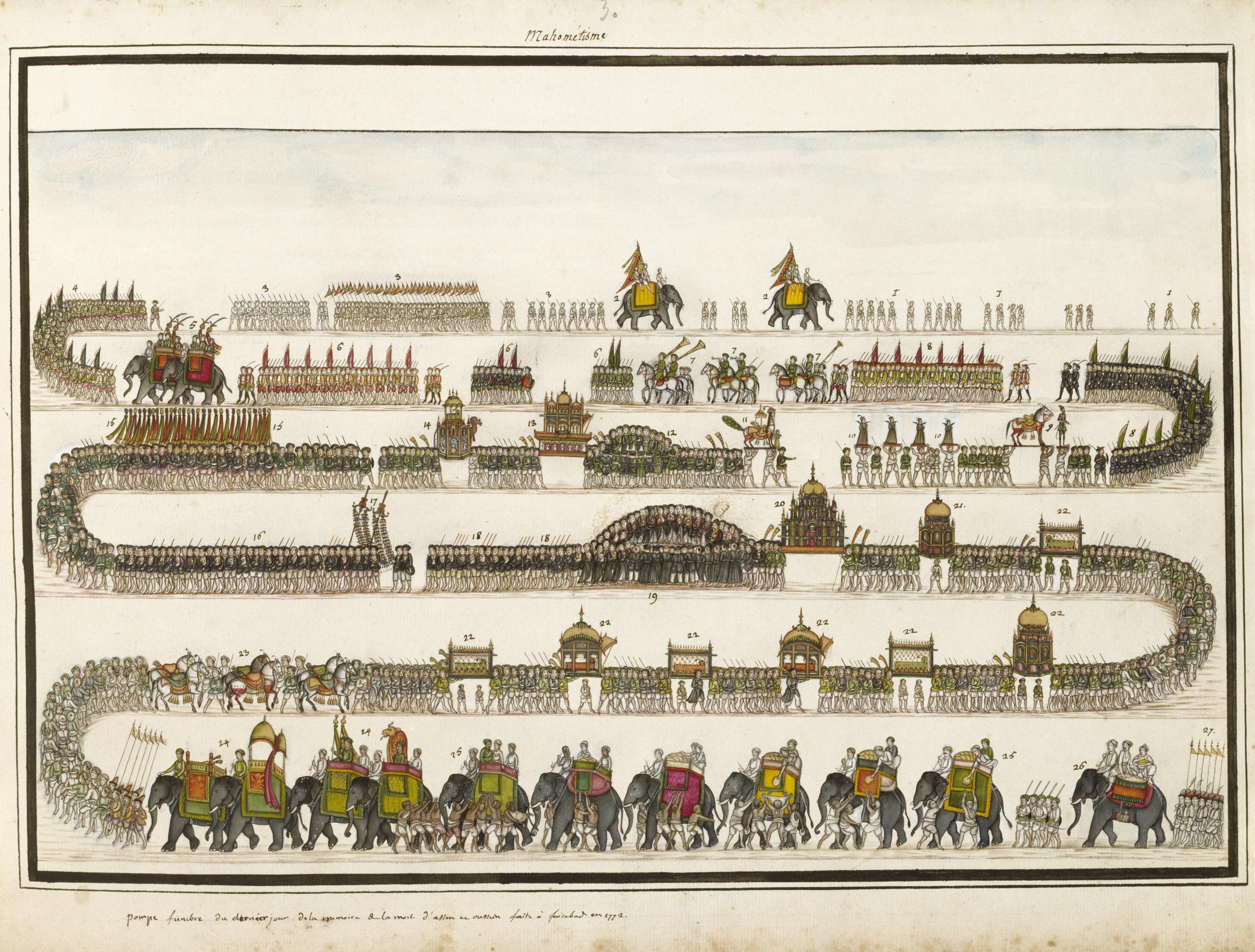
Muharram Procession in Faizabad During Rule of Shuja Ud Daula
Dr.Mazhar Naqvi
Colonel Jean-Baptiste Gentil, a
French military officer, deserves mention in mourning assemblies and Karbala
literature.It was he who had retained an anonymous artist or artists to
draw a mourning procession during the observance of Muharram in Faizabad In
1774.Though it is not certain what propelled Colonel to do so but the painting
produced by the artist/artists retained by him certainly portray the grandeur
of Muharram mourning in Faizabad. It can also be safely said that the painting
is probably the earliest of its kind after Awadh came under the rule of Nawabs
in 1722.The first two Nawabs of Awadh Burhan- Ul- Mulk and Safdarjang did not
get much time to develop their capital and they remained busy in either military
engagements or handing court politics in Delhi.
It was third Nawab Shuja-Ud-Daula
who made Faizabad his capital after ascending throne. He was an ambitious ruler
and wanted to have a well-trained army as well. He recruited French Officers to
train his soldiers. The British did not like the idea and made all out efforts
to discourage Shuja Ud Daula for undertaking such activities. It is also
evident from the battle of Buxar that
Shuja Ud Daula had realized true intentions of the British and therefore, he
fought against them with Mir Qasim. Unfortunately,
the British won and were able to penalize Shuja-Ud-Daula severely. He had to accept
certain very disgraceful conditions to save his throne.
The defeat of Buxar dampened the
spirit of Shuja-Ud-Daula. To overcome depressing tendencies, he concentrated on
giving fillip to Azadari and development of Faizabad as a capital town. His
efforts attracted many a traders, merchants, artists, poets and men of letters
from various places, including Delhi. In a short span of time, Faizabad became
a great city and hub of all sorts of activities. Out of his sheer devotion to Holy
Prophet and his progeny, Shuja Ud Daula made the observance of Muharram a grand
affair in Faizabad. To what extent Azadari attained regal touch is exemplified
from the painting made at the instance of Colonel Gentil.
The descending scale of figures
implies their movement in the painting. The party is led by soldiers and
elephants, followed by bearers of standards (alam) that commemorate the martyrs
of Karbala led by Imam Hussain. Some hold aloft models of symbolic figures,
including beautiful maidens (houris) and the mythological steed Buraq,
while others hold replica of the shrine
of the martyred Imam(Tazua), as well as models of their coffins (ta‘but).
Knots of mourners chant elegies of the battle (marsiya) and weep as they
beat their chests (matam). In the largest group, a man is labeled as
the nawab of the region; his presence defines this as an elite
procession. Evoking sound, touch, and sight, the image also nods to the scent
of flowers streaming from some of the standards, and even to taste. At the
finale, supplicants distribute bread to devotees and the hungry from atop
elephants.
The painting is reportedly
preserved in Victoria and Albert Museum in London. It is part of Colonel’s
album and appears on page 30.The painting is in water color on paper with its
size as 37 x 53.5 cm. The museum considers it as its one of the proud possessions
since it not only reveals the grand scale of Muharram Observance in Faizabad by
the third quarter of 18th century but also perhaps the first
painting on Ashura after formation of Awadh dynasty.It is worth mentioning here
that Faizabad had lost much of its sheen after Shuja Ud Daula as his son Asaf
Ud Daula had shifted his capital to Lucknow after becoming the
ruler.(References available on request. Photo Courtesy Google Images/Victoria
Albert Museum,London)
No comments:
Post a Comment